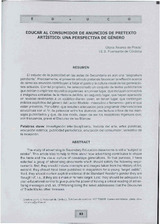Educar al consumidor de anuncios de pretexto arístico: una perspectiva de género
Autor
Álvarez de Prada, Gloria
Editor
Universidad de Córdoba, Servicio de PublicacionesFecha
2006Materia
Investigación interdisciplinariaHistoria del arte
Artes plásticas
Educación estética
Publicidad periodística
Educación del consumidor
Semiótica de la recepción
Interdisciplinary research
History of art
Plastic arts
Aesthetic education
Press advertising
Consumer education
Semiology of receiver
METS:
Mostrar el registro METSPREMIS:
Mostrar el registro PREMISMetadatos
Mostrar el registro completo del ítemResumen
El estudio de la publicidad en las aulas de Secundaria es aún una “asignatura pendiente". Precisamente, el presente artículo pretende favorecer la reflexión acerca de cómo los anuncios contribuyen a forjar el gusto y la cultura visual de las generaciones actuales. Con tal propósito, he seleccionado un conjunto de textos publicitarios
que debían cumplir los requisitos siguientes: en primer lugar que incluyan conceptos e imágenes extraídas de la Historia del Arte; en segundo lugar que hayan aparecido en revistas destinadas a un «público-diana» joven: en tercer lugar que contengan indicios explícitos del género del Lector Modelo -masculino o femenino- para el que están previstos. Por último, que resulten adecuados para programar intervenciones educativas con el fin de potenciar entre los alumnos una lectura crítica de los mensajes publicitarios y que, de ese modo, dejen de ser los receptores ingenuos que, con frecuencia, prevé el Discurso de las Marcas. The study of advertising in Secondary Education classrooms is still a "subject to
retake". This article tries to help to think aboul how advertistng contributes to shape the laste and the visual culture of nowadays generalions. To thatpurpose, I have selected a group of advertising documents which should satisfy the following requtrements: first, they should include concepts and images taken from the History of Art; second, they should have been published in magazines for a young 'target public"; third, they should contain explicit evidence of de Standard Reader's gender they are thought of, i.e., if they are a male or female target. Last, they should be adequate to plan educational control to give pupils the power of having a critica! reading of advertising messages and, so, of finishing being the naive addressees that the Discourse of Trade Marks often foresees.

